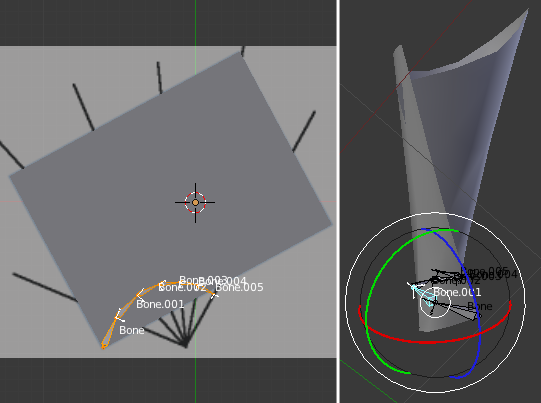Is it possible to create a surface that is realisticly bend like a curled sheet of paper?
Take a rectangular sheet of paper and curl it so that you get a funnel. I want to get exactly this form.
Do you have any idea how to achieve this?
Is it possible to create a surface that is realisticly bend like a curled sheet of paper?
Take a rectangular sheet of paper and curl it so that you get a funnel. I want to get exactly this form.
Do you have any idea how to achieve this?
Add a rectangle with the dimensions of your sheet of paper. Subdivide it a few times (W-Key). Add loopcuts near the edges (CTRL-R). Add a subdivision surface modifier for a smoother surface.
Add a bezier curve and move the control points into a spiral.
Now select the sheet of paper and add a curve modifier (the modifiers are in the properties panel in the tab that has a wrench on it). You might need to change the deformation axis, but you should already see your sheet curled along the curve. Move the sheet of paper (G-Key) to move it along the curve.
Now for the trick. Make sure the curve is a 3D curve (it should be by default), and select one of the control points. Change it’s tilt, either in the curve menu or by using CTRL-T.
You can try simple deform. I had no success with that. With simple deform, geometry will stretch you know. Paper will loose its original shape as you deform it.
For folding paper or rolling one use Armature for the job. As bones are folded, the geometry associated with that bone object would keep its shape.
Curling to cone shape is basically bending paper in a radial pattern. You need to have this radial cut on rectangular paper. Make a fold layout in Gimp. Use it as a background image template to make the cuts on plane. You need the template to layout the bones as well. Bone head needs to meet the cut line at 90 degrees. Set bone to parent “With empty group” option and assign fold vertexes to associated bone. Now you can roll it up with “Normal” Transform orientation along the fold line in Pose mode:

@see360: Thanks for your hint. working this way I get lots of control over the surface but it will bend in a way that paper could not be bend.
@ridix: Wow. This is the first hint that is actually pointing in the right direction. And I asked this in several forums for several different programs. Thanks.
It works but well. It is very very complicated.
Since the rendering should be used on a poster. It has to be very precise. To get a perfect result I have to define many bones at the beginning of the process, not beeing able to forsee the result. I was looking for a method that allows me to play around with the form. I don’t think that it will be possible with this method.
You can:
Estimated time: 3 minutes.
@damien: As I said earlier, any deformation using the lattice modifier changes the size of the surface. This is a deformation that can’t be done with a sheet of real paper. Try it in the real world. The form is different from whar you are proposing.
can you explain how this cloth can follow the cone?
i can see an armature with one bone but not certain how cloth can follow it !
thanks
Sure… the cone is animated to rotate using an armature or as object animation. The “paper” has a “pin” vertex group for “pinning” on the edge that is next to the cone. The cloth is a child of the cone, or armature if using one, so the pin group is affected by that relationship. The cone is a collision object.
Sweet solution, Pappy.
do you a sample file
cannot make it work !
i tried to manually rotate the bone on the cone and everything simply rotate around the bone = cone + Paper!
i made cone parent to armature and cone as a collision object and paper as a cloth
so not certain why rotate affects all but cloth is not going around the cone itself!
thanks
Ok, so play with the lattice then unwrap with follow active quad option!
a simple animation but yet i find it impressive for what it does
thanks
I’m agree with you rickyblender.
Thank you pappy. Still not the easiest way. But at least a working solution.
I appreciate that this is an old conversation and it is possible that there are now answers to the question of curling a 2D (or thin) mesh while preserving its area.
(Incidentally, there must be a mathematical term for this).
My own interest is in modelling flowers, leaves etc. and I would love to find a straightforward way of moving vertices in a 2D mesh in such a way that edge lengths are preserved. The image below shows the sort of thing I would like to be able to do:
I would like to be able to perform different curls on different copies of the same underlying mesh, in order to model variety.
It amazes me that there isn’t a tool for doing this kind of thing - including rolling paper into cones.
I have tried using armatures (too complicated)
So far some of the best results have been through modelling my mesh as cloth and exposing it to a turbulent wind, which I can freeze at various moments to get a variety of instances:
I’d welcome any ideas or to hear from others who are trying to do this kind of thing.